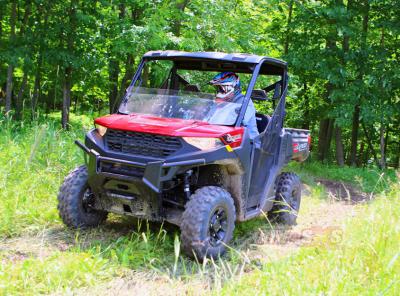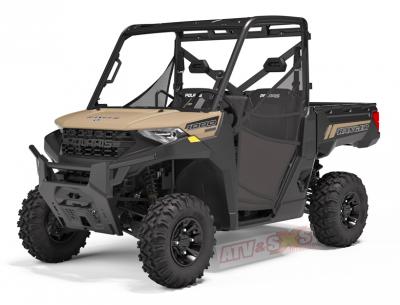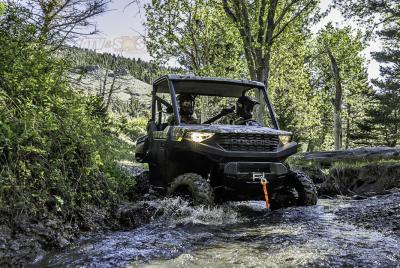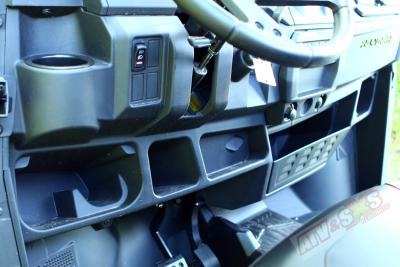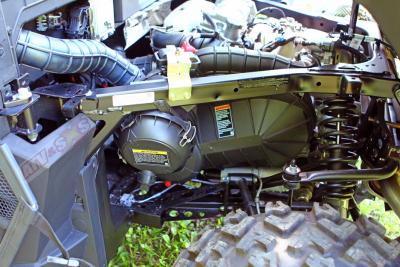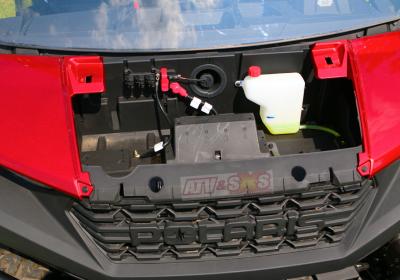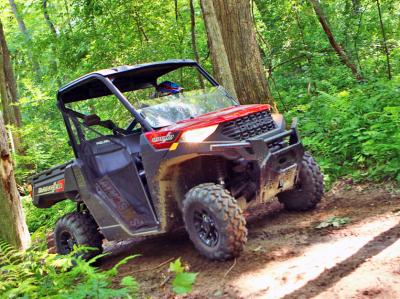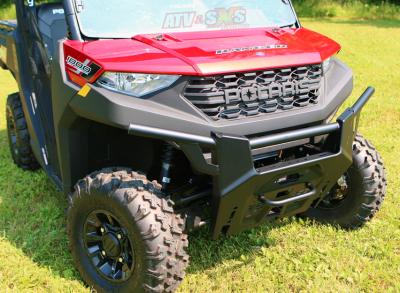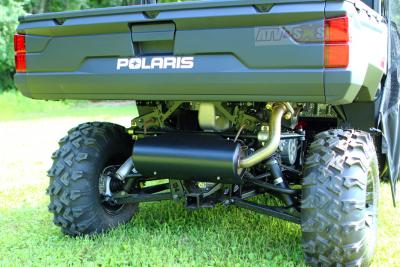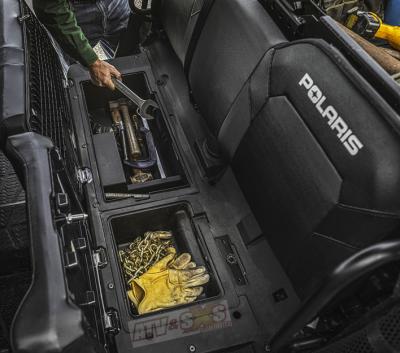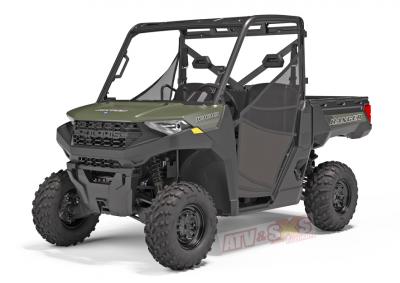When Polaris introduced the first Ranger two decades ago it joined the ranks of the John Deere Gator and the Kawasaki Mule, both strictly utility vehicles dedicated to long days of toiling away on ranches and construction sites. Thoughts of recreation were little more than one would apply to a tractor. There have been several generations since, with advancements in performance, handling, and comfort that have made the Ranger one of the most successful vehicles of all time. The Ranger has never strayed far from its working class roots, but their recreational capabilities are outstanding, and the Ranger 900 grew to become a legend. Still, as all legends eventually are, it too was slated for retirement.
THE NEW RANGERS
You don’t replace a legend without very carefully considering all the implications, and you can bet the Polaris planning team had some long discussions on just what the new Ranger would need. Above all, it needed to not only offer value to the user in capability, but in price. What Polaris came up with is truly impressive. A few quick details are:
-
New, one piece chassis for less flex and chassis noise, and increased strength
-
New 1000cc ProStar engine tuned for drive-ability and torque
-
2,500 lb. Towing Capacity, 1,500 lb. Payload Capacity, 1,000 lb. Box Capacity
-
New comfort cab with increased storage, more leg room, and easier entry / exit.
-
Tighter turning radius for increased maneuverability
-
Deeper cargo bed sides for increased capacity
-
Option packages that allow you to outfit the Ranger exactly as you need it, right from the factory
-
Best Ranger pricing ever, beginning at $12,999
NEW BODY STYLE INSIDE and OUT
Before we drive any new vehicle we take a close look at the details. The first thing we like about the new Ranger 1000 is the styling. Polaris did a great job with the bodywork. It flows nicely across different body panels and surfaces, and it presents a bold, capable look. We especially like the front nose which sits slightly higher than on previous models, yet doesn’t limit the drivers view over the hood. Under the front hood are electrical connections and a bus bar that is pre-wired for adding accessories. They’re even marked for position and it makes adding accessories quick and easy. Another great feature is the grill insert which, without any tools, can easily be removed for cleaning and then snapped back into place. It shows the Polaris engineering team considered ease of maintenance, which is a big part of ownership. A sturdy, steel tube bumper protects the front end, and it even includes a loop for strapping the Ranger down to your trailer.
At the rear of the Ranger 1000 is a cavernous cargo box that can haul more than ever before. The bed is identical to the one on the Ranger XP 1000, with taller sides, a sloped bottom that drains easily, and pockets for integration of Polaris accessories. The bed sides even get a textured surface to hide scuffs and scrapes which are bound to happen. Remember, this is a machine not afraid of any work.
Polaris went all out with the cab interior of the Ranger 1000. We absolutely love the flip up seats and huge storage bins beneath, but there is storage under the dash, 6 cup holders, and sealed storage in the dash as well. All controls are easily accessed by the driver, and a large, digital display is just ahead of the steering wheel, right where it should be. Down below, there is plenty of room for your feet and a textured floorboard helps grip your boots and hold your feet in place. Best of all, the seat bases offer 25% more padding for extra comfort, with contoured surfaces to help hold you in place.
CHASSIS and ENGINE SPECS
Polaris gave the Ranger 1000 an all new chassis and we really like it. Rather than bolting several individual pieces together, this chassis is a one-piece, fully welded design. That means it is much more rigid, but also quieter thanks to fewer bolted joints. Suspension bushings are now fully sealed, further quieting the ride, and the engine is under the rear bed, again pushing the noise to the rear. At the front are dual A-arms for a smooth ride, and the rear offers independent control arms. Wheel travel is listed at 10” at each end, with 12” of ground clearance on 25” tires which is more than enough for a supple ride over trail obstacles or rough fields. With increased towing and hauling capabilities comes a secondary concern however; braking. It’s not enough to just get a load rolling, you also have to stop it safely. To make sure that was not a problem Polaris gave this Ranger 1000 the same brake system as found on the heavy duty Ranger XP 1000.
There are many common parts between the new Ranger 1000 and the top of the line Ranger XP1000, and the most important part is the ProStar engine. Other than the cylinder heads the two engines are identical. The difference is, the head on the new Ranger 1000 features a single overhead cam. While it makes slightly less overall power (61hp) than the XP 1000, this engine is all about torque for towing and hauling and it delivers the power exactly where you need it. As with every Polaris, power is delivered through a CVT transmission. Access to the CVT cover is excellent, and Polaris gave it a heavy duty belt. The air intake and filter also is a new design, with the cover and filter easily removed in less than a minute, and without tools. Access is under the cargo bed on the left side of the engine. The oil filter is in a unique but equally handy position. It’s right behind the CVT at the front of the engine, and you can reach it easily from the top. A dip stick makes quick oil checks easy, and a large fill hole at the top of the engine is perfect for refilling after a change. Polaris did very well with the maintenance tasks on the Ranger 1000 ProStar engine.
RANGER RIDE TIME
Settling into the drivers seat, everything felt completely familiar with the Ranger 1000 and the thicker seat foam was very comfortable. With a twist of the key the engine sprang to life and we slipped the shift lever into High. Polaris had an interesting obstacle course setup for us, and we piloted the Ranger over rock fields, hills, and even a balance table designed to show the smooth engagement of the CVT system. As expected for any Ranger, it handled all the obstacles easily so we quickly went looking for more tests on our own. The test area was heavily wooded, with trails in every direction. There are hills, huge piles of dirt stockpiled from previous projects, streams to cross, and plenty of downed timber and tight trails. A day of riding here would prove to be an excellent gauge of the Ranger 1000s capabilities.
The first thing we noticed about the Ranger 1000 is that it is very quiet. Having the engine mounted in the rear definitely keeps the cab noise to a minimum, and it was easy to have a normal conversation with your passenger. The extra leg room is also a welcome feature. We’ve always found the Rangers to have the smoothest ride in the class, and the new Ranger 1000 definitely continues that tradition. It simply floats down the trail. Excellent handling is also a trademark of the Ranger lineup, and again the 1000 does not disappoint. It carves through the trails easily and precisely, with little body roll even when being driven aggressively. This Ranger even improves on the handling of previous models by having an even tighter turning radius. That means tight turns on the trail are easier than ever. Although the standard steering on the base model is completely functional, we recommend stepping up to an EPS (Electronic Power Steering) equipped model. It makes all day drives a joy and you’ll never regret having it. The EPS still delivers a good feel of the trails, and whether you are in 2WD, 4WD, or in Turf Saver mode (with the rear differential unlocked) the steering feels responsive and light.
Polaris worked very hard to tune the engine power output for high torque without any jerky, abrupt engagement. Mission accomplished! Despite having enough power to pull over a ton behind with another 1000 lbs piled into the cargo bed, the CVT engages very smoothly and predictably. The Ranger picks up speed quickly and both upshifts and downshifting of the CVT are barely noticeable. We also didn't notice any whine from the CVT or drive line, and the suspension bushings were noticeably quieter. About the only thing we didn’t really care for are the side nets, and we would opt for a set of the Polaris doors, or high quality aftermarket doors. The nets are functional, but doors are easier and provide a little more protection.
Our overall assessment of the new Ranger 1000 is pretty much exactly what we expected of a machine with such an impressive heritage. It’s comfortable, quiet, capable, it handles excellent, and the power is perfectly matched to the chassis. Although Polaris offers a whopping 22 models in the Ranger lineup, it will be very, very difficult to pass by the new Ranger 1000.
THE BOTTOM LINE
Without a doubt the new Polaris Ranger 1000 offers enormous value for the dollar. There is really nothing we dislike about it. For the base price of $12,999 you get most of the top-of-the line features found on the Ranger XP 1000, but at a substantial discount, and the performance and handling is outstanding. Option packages let you configure the Ranger for under $15k. There aren’t many hard working Side x Sides this well equipped that can match that price. As one legendary player leaves the field, a promising rookie enters the game.
2020 POLARIS RANGER 1000 SPECIFICATIONS
Engine: 999cc, Liquid Cooled, EFI equipped SOHC Twin Cylinder 4-stroke, 61hp
Drive System: On Demand, True AWD/2WD/VersaTrac with Turf Mode
Transmission: Automatic PVT H/L/N/R/P; Shaft
Box Capacity 1,000 lb (453.6 kg)
Dry Weight 1,429 lb (648 kg)
Fuel Capacity 11.35 gal (43 L)
Ground Clearance: 12 in (30.5 cm)
Towing: 2,500 lb (1,133.9 kg)
Overall Size: (L x W x H)120 x 62.5 x 76 in. (305 x 158 x 193 cm)
Payload: 1,500 lb (680.4 kg)
Riders 3
Wheelbase 81 in (206 cm)
Brakes: 4-Wheel Hydraulic Disc with Dual-Bore Front and Rear Calipers
Parking Brake Park In-Transmission
Hitch Type Standard 2 in (5 cm) Receiver
Instrument 4" LCD Information Center: User Selectable Blue/Red Backlighting & Brightness, Programmable Service Intervals, Speedometer, Tachometer, Odometer, Tripmeter, Clock, Hour Meter, Gear Indicator, Fuel Gauge, Coolant Temperature, Voltmeter, Service Indicator and Codes, Seat Belt, DC Outlet
Lighting: 55W low/ 60W high, LED Tail
Other Features Polaris Pulse Electrical System (3 position)
Tilt Steering Standard
Tires / Wheels Front Tires25 x 10 -12; 489, Rear Tires25 x 11-12; 489
Wheels: Stamped Steel
Suspension: Front – Dual A-Arm 10 in. (25.4 cm) Travel, Rear - IRS 10.0 n (25.4 cm) Travel
Colors: Sage Green, Solar Red
MSRP: $12,999
Option Packages:
RANGER 1000 EPS
Includes: Electronic Power Steering
Colors: Sage Green, Solar Red, Polaris Pursuit Camo
MSRP: $13,999
RANGER 1000 PREMIUM
Includes: Electronic Power Steering
Adjustable Seat Slider
Premium Front Bumper
Premium Automotive Paint
26” PXT 2 tires
Aluminum Black Xcelerator Wheels
Colors: Sage Green, Solar Red, Matte Military Tan
MSRP: $14,999


